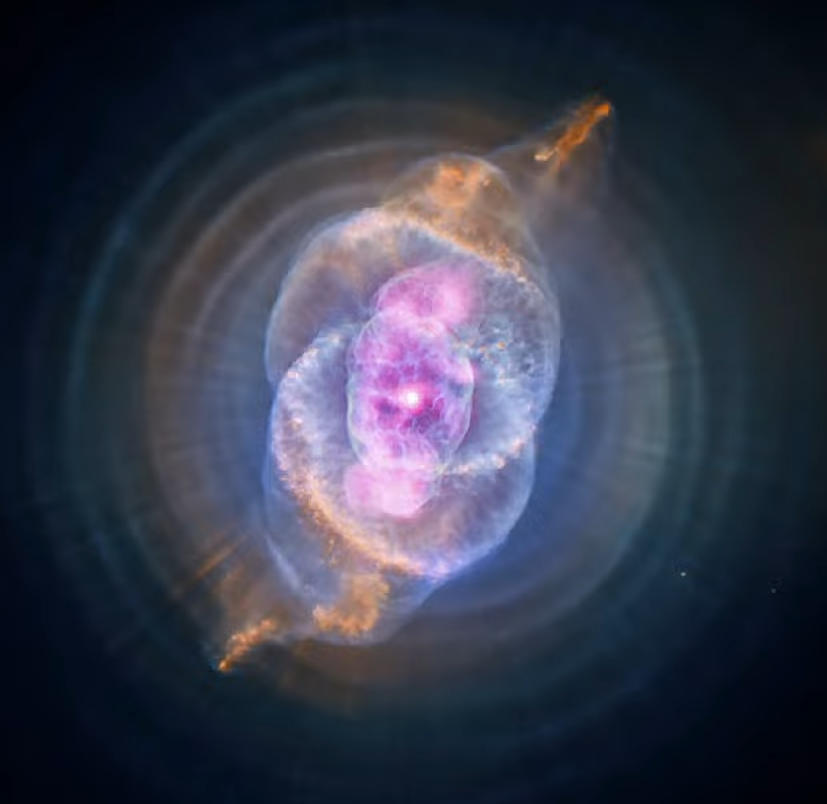

Hubble Uzay Teleskobu tarafından çekilen Kedi Gözü Bulutsusu’nun görüntüsü. Kredi: NASA/CXC/SAO/K.Arcand, SYSTEM Sounds (M. Russo, A. Santaguida)
Gökbilimciler, Kedi Gözü Bulutsusu’nda mükemmele yakın simetriye sahip halkaları keşfediyor
Araştırmacılar, Kedi Gözü Bulutsusu’nun bilgisayar tarafından oluşturulan ilk 3B modelini oluşturarak, bulutsunun dış kabuğunun etrafındaki bir çift simetrik halkayı ortaya çıkardı. Halkaların simetrisi, bunların bulutsunun merkez yıldızından kaynaklanan bir jet akımı tarafından oluşturulduğunu gösterir. Bu, bulutsunun merkezindeki bir ikili yıldız için güçlü kanıtlar sağlar. Çalışma yakın zamanda dergide yayınlandı. Kraliyet Astronomi Derneği’nin Aylık Bildirimleri Ryan Claremont tarafından yönetildi.
Bir gezegenimsi bulutsu, ölmekte olan bir yıldızın dış gaz tabakasını çıkarması ve gezegenimsi bulutsuların karakteristik özelliği olan renkli, kabuk benzeri yapıyı oluşturmasıyla oluşur. NGC 6543 veya Kedi Gözü Bulutsusu, bilinen en karmaşık gezegenimsi bulutsulardan biridir. Dünya’dan sadece 3.000 ışıkyılı uzaklıkta ve Draco takımyıldızında görülebilir. Kedi Gözü Bulutsusu da ayrıntılı olarak gözlemlenmiştir.[{” attribute=””>Hubble Space Telescope, exhibiting a complicated structure of knots, spherical shells, and arc-like filaments.

A side-by-side comparison of the three-dimensional model of the Cat’s Eye Nebula created by Clairmont and the Cat’s Eye Nebula as photographed by the Hubble Space Telescope. Ryan Clairmont (left), NASA, ESA, HEIC, and The Hubble Heritage Team (STScI/AURA) (right) (CC BY-NC-SA 4.0).
The nebula’s mysterious structure confounded astrophysicists because it could not be explained by previously accepted theories for planetary nebula formation. More recent research showed that precessing jets were potential shaping mechanisms in complex planetary nebulae such as NGC 6543, but lacked a detailed model.
Clairmont, an astronomy enthusiast, decided to try to establish the detailed 3D structure of the Cat’s Eye to find out more about the potential mechanism that gave it its intricate shape. To do this, he sought out the help of Dr. Wolfgang Steffen of The National Autonomous University of Mexico and Nico Koning from the University of Calgary, who developed SHAPE, 3D astrophysical modeling software particularly suitable for planetary nebulae.
The researchers used spectral data from the San Pedro Martir National Observatory in Mexico to reconstruct the nebula’s three-dimensional structure’s three-dimensional structure. These provide detailed information on the internal motion of material in the nebula. Together with these data and images from the Hubble Space Telescope, Clairmont constructed a novel 3D model, establishing that rings of high-density gas were wrapped around the outer shell of the Cat’s Eye. Surprisingly, the rings are almost perfectly symmetric to each other, suggesting they were formed by a jet – a stream of high-density gas ejected in opposite directions from the nebula’s central star.
The jet exhibited precession, similar to the wobbling motion of a spinning top. As the jet wobbled, or precessed, it outlined a circle, creating the rings around the Cat’s Eye. However, the data indicates the rings are only partial, meaning the precessing jet never completed a full 360-degree rotation, and that the emergence of the jets was only a short-lived phenomenon. The duration of outflows is an important piece of information for the theory of planetary nebulae. Since only binary stars can power a precessing jet in a planetary nebula, the team’s findings are strong evidence that a system of this type exists at the center of the Cat’s Eye.
As the angle and direction of the jet changed over time, it likely formed all of the features seen in the Cat’s Eye, including the jets and knots. Using the three-dimensional model, the researchers were able to calculate the tilt and opening angle of the precessing jet based on the orientation of the rings.
Ryan Clairmont, the lead author of the paper and now a prospective undergraduate at Stanford University stated, “When I first saw the Cat’s Eye Nebula, it was astonishing. It had a beautiful, perfectly symmetric structure. I was even more surprised that its 3D structure was not fully understood.”
He continued, “It was very rewarding to be able to do astrophysical research of my own that actually has an impact in the field. Precessing jets in planetary nebulae are relatively rare, so it’s important to understand how they contribute to the shaping of more complex systems like the Cat’s Eye. Ultimately, understanding how they form provides insight into the eventual fate of our Sun, which will itself one day become a planetary nebula.”
Reference: “Morphokinematic modelling of the point-symmetric Cat’s Eye, NGC 6543: Ring-like remnants of a precessing jet” by Ryan Clairmont, Wolfgang Steffen and Nico Koning, 15 September 2022, Monthly Notices of the Royal Astronomical Society.
DOI: 10.1093/mnras/stac2375

“Analist. Tutkulu zombi gurusu. Twitter uygulayıcısı. İnternet fanatiği. Dost pastırma hayranı.”





More Stories
Bilim insanları dünyadaki en büyük demir cevheri yataklarında milyar yıllık bir sırrı keşfetti
Fosillere göre tarih öncesi deniz ineği, timsah ve köpekbalığı tarafından yenildi
Büyük bir bindirme fayı üzerine yapılan yeni araştırma, bir sonraki büyük depremin yakın olabileceğini gösteriyor